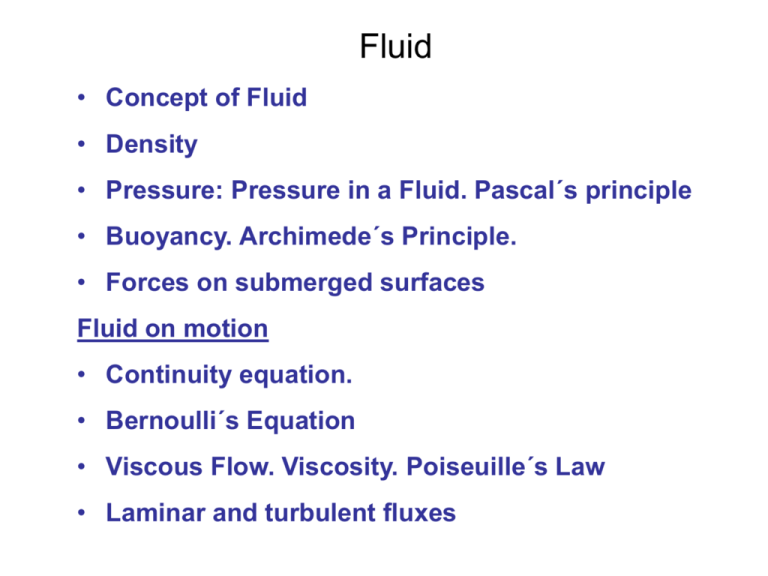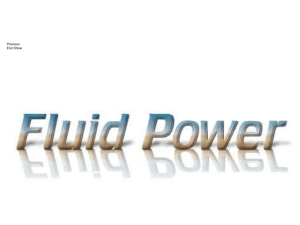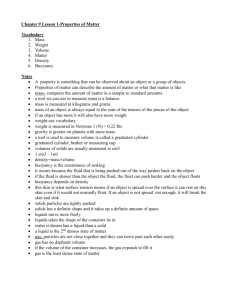Diapositiva 1
advertisement

Fluid • Concept of Fluid • Density • Pressure: Pressure in a Fluid. Pascal´s principle • Buoyancy. Archimede´s Principle. • Forces on submerged surfaces Fluid on motion • Continuity equation. • Bernoulli´s Equation • Viscous Flow. Viscosity. Poiseuille´s Law • Laminar and turbulent fluxes Fluid. Introduction • A fluid is defined as a substance that flows A fluid is defined as a substance that continually deforms (flows) under an applied shear stress regardless of how small the applied stress. All liquids and all gases are fluids. Fluids are a subset of the phases of matter and include liquids, gases, plasmas and, to some extent, plastic solids. Liquids flow under gravity until they occupy the lowest possible regions of their containers (they have defined volume but not a defined shape). Gases expand to fill their container (they have no neither defined shape and volume Liquids form a free surface (that is, a surface not created by the container) while gases do not. Fluid. Introduction • A fluid is defined as a substance that continually deforms (flows) under an applied shear stress regardless of how small the applied stress The distinction between solids and fluid is not entirely obvious. The distinction is made by evaluating the viscosity of the substance. Fluids display such properties as: - not resisting deformation, or resisting it only lightly (viscosity), and - the ability to flow (also described as the ability to take on the shape of the container). These properties are typically a function of their inability to support a shear stress in static equilibrium. FLUID. Distinction between solids and fluid. About shear stress Tensile stress F/A Tensile Strain ∆L/L A solid body has a defined shape. Rigid Body is a idealized concept of a solid body. Rigid Body is defined as a body which does not deform under acting forces on it If a real solid body is subjected to forces that tend to stretch, compress or shear the object, its shape changes, reaching a new status of equilibrium between external and internal forces. - If the object returns to its original shape when the external forces are removed, it is said to be elastic. Most objects are elastic for forces up a certain maximun, called the elastic limit. If the acting forces exceed of elastic limit the object remains permanently deformed or it is fractured. Shear Stress Fs/A Shear Strain ∆X/L Solids can be subjected to shear stresses, and to normal stresses - both compressive and tensile. In contrast, ideal fluids can only be subjected to normal, compressive stress which is called pressure. Real fluids display viscosity and so are capable of being subjected to low levels of shear stress. FLUID. Fluid Statics, Hydrostatics; Fluid dynamics; hydraulics Fluid statics (also called hydrostatics) is the science of fluids at rest, and is a sub-field within fluid mechanics. The term usually refers to the mathematical treatment of the subject. It embraces the study of the conditions under which fluids are at rest in stable equilibrium. The use of fluid to do work is called hydraulics, and the science of fluids in motion is fluid dynamics. Hydraulics is a topic of science and engineering dealing with the mechanical properties of liquids. Hydraulics is part of the more general discipline of fluid power. Fluid mechanics provides the theoretical foundation for hydraulics, which focuses on the engineering uses of fluid properties. Hydraulic topics range through most science and engineering disciplines, and cover concepts such as pipe flow, dam design, fluid control circuitry, pumps, turbines, hydropower, computational fluid dynamics, flow measurement, river channel behavior and erosion. FLUID. Density • Density. An important property of a substance is the ratio of the mass to its volume, which is called density Specific weight SI Units : kg/m3 The density of water at 4ºC is 1000 kg/m3 [1 kg/l] [1 g/cm3] dm g g dV The ratio of the density of a substance to that a water is called the specific gravity Density must take temperature into account, since the densities of most materials vary with temperature. In the case of water, maximum density occurs at 4ºC Most solids and liquid change only slightly in volume when heated or under an increase of external pressure. The density of a gas depends strongly of the pressure and temperature Density. Advanced concept The concept of density is referred to a determined point of the body dm m lim V 0 dV V Specific volume is the inverse of density and it is defined as the ratio of the volume to its mass FLUID. Density • Density. dm dV The density of water at 4ºC is 1000 kg/m3 [1 kg/l] [1 g/cm3] The density of air at 0ºC and 1 atm of pressure is 1.293 kg/m3 Density of water versus temperature Temp (°C) Density (g/cm3) 30 0.9957 20 0.9982 10 0.9997 4 1.0000 0 0.9998 −10 0.9982 −20 0.9935 −30 0.9839 Build a table of densities of Gold, Mercury, Water, Wood, Air, and Helium. Include also typical soil density, FLUID. Pressure • Pressure in a fluid When a body is submerged in a fluid such as water, the fluid exert a force perpendicular to the surface of the body at each point on the surface. This is a “distributed force”. Pressure is the ratio between the normal force, FN and the elementary area, A, where it is applied. FN P A SI Units: The Pascal [Pa] is the pressure exerted by a force of one Newton uniformly distributed on one square meter. Another common unit of pressure is the atmosphere (atm), which equals approximately the air pressure at sea level 1 atm = 101.325 kPa The pressure due to a fluid pressing in on an object tends to compress the object. The ratio of the increase in pressure ΔP to the fractional decrease in volume -(ΔV/V) is called the bulk modulus FLUID. Pressure • Different behavior of liquids and gases to an increase of pressure. Bulk modulus and the compressibility modulus The pressure due to a fluid pressing in on an object tends to compress the object. The ratio of the increase in pressure ΔP to the fractional decrease in volume -(ΔV/V) is called the bulk modulus. P V V The compressibility modulus is the reciprocal of bulk modulus (1/B) Liquids and solids are relatively incompressible, they have large values of B. On the other way, the density of liquid and solids is relatively constant with pressure changes Gases are easily compressed and the values of B are strongly dependent on pressure changes. The density of gases depends strongly of pressure changes, besides of changes in temperature. FLUID. Pressure. • Change of pressure with height in a static fluid in a gravitational field. Hydrostatic equation dz g z We can detach the volume of fluid from the rest of the fluid, as shown in the figure. This volume will be at equilibrium in a static fluid under a gravitational field. Free-body diagram Static condition Fext O on the volume Fz 0 P dS ( P dP)dS g dV 0 (P + dP) dS and as dm g dV g P dS The vertical forces acting on the volume are those exerted by the rest of the fluid and by the weight. Horizontal forces are not showed in the figure because they will be balanced. dV dS dz dP g dz In the case of a liquid, ρ constant, P g h P P0 g h The pressure P at the bottom must be greater than the pressure at the top to balance the weight of the fluid The pressure in a pool (lake or ocean) increases with depth. Similarly, the pressure of the atmosphere decreases with altitude. Po h P FLUID. Pressure. • Hydrostatic equation. Change of pressure with depth in a static fluid in a gravitational field. Po dP g dz In the case of a liquid, ρ constant, P g h h P P0 g h P • The pressure increase linearly with the depth, independent of the shape of the container •The pressure is the same at all point at the same depth Pascal´s principle: A pressure change applied to an enclosed liquid is transmitted undiminished to every point in the liquid and to the walls of the container. Hydrostatic paradox: The pressure depends only on the depth of the water not on the shape of the container, so at the same depth the pressure is the same in all parts of the container Many applications are based on the hydrostatic equation: Hydraulic lift, hydraulic system, horizontal lines (using water connected vessels)… FLUID. Pressure. P g h Po P P0 g h Hydraulic lift h Derive the relationship for the forces in the pistons of hydraulic lift, considering the hydrostatic equation (Pascal´s Principle P Hydrostatic paradox Explain why : 1.- the free surface of liquid will adopt the horizontal line. 2.- The pressure at the bottom at a different point will be the same FLUID. Pressure. P g h Po P P0 g h h Determine the difference of pressure between point 1 and 2. P FLUID. Pressure Measuring pressure We can use the fact that the pressure difference is proportional to the depth of a liquid to measure unknown pressures, that is, the pressure in the container. Measuring gauge (gage) pressure: the open-tube manometer. Measuring Atmospheric Pressure. The mercury barometer Pat=ρHggh ρHg density of mercury The top of the tube is open to the atmosphere at pressure Pat. The other end of the tube is at pressure P, which is to be measured. The difference P – Pat, called the gauge pressure, will be P – Pat = ρ g h What is the height of the mercury column in a barometer if the atmospheric pressure is 1 atm (101.325 kPa)?. The density of mercury at 0ºC is 13.595x103 kg/m3. The same if the liquid in the column were water at 4 ºC The absolute pressure in the container is obtained from the gauge pressure by adding atmospheric pressure to it: P = Pat + ρgh FLUID. Pressure Measuring pressure. Common pressure units The pressure you measure in your automobile tire is gauge pressure. The absolute pressure in the tire can be obtained from the gauge pressure by adding the actual atmospheric pressure measured by the barometer. Exercise: The recommended pressure in a type of tire is 2.5 bar. What is the absolute pressure if the local atmospheric pressure is 933 mbar? 101325 Pa [Pascal] 1 atm [atmosphere] 1.01325 bar 760 mmHg [millimeter of mercury] 10.33 mH2O [meter of water] 1.0332 kgf/cm2 bar = 100 kPa mbar [milibar] Kilogram of force per square centimeter also called technical atmosphere What is the minimum value of the absolute pressure? What is the maximum value of suction that can be exerted? FLUID. Buoyancy. Buoyancy. Archimede´s Principle. A body wholly or partially submerged in a fluid is buoyed by a force equal to the weight of the displaced fluid Apparent weight of the submerged body Deriving Archimede´s principle from Newton´s Laws W =ρF V g Buoyant force B The submerged body is replaced by an equal volume of fluid (dashed line). The detached volume is at equilibrium weight balancing its own weight by the buoyant force exerted on it by the rest of the fluid. The weight of a body at air is 154.4 N. The same body submerged in water has an apparent weight of 146.4 N. From which material is the body made ? Then, the value of the buoyant force on the submerged body must be the weight of the displaced fluid. The line of action of the buoyant force passes through the center of mass of the volume. This result does not depend on the shape of the submerged object FLUID. Buoyancy. The apparent weight of the child, when he is completely submerged in water, with the air completely exhaled from his lungs, is 5% of his weight. What percentage of his body is fat?. The density of fat ~0.9x103 kg/m3, and the density of lean tissue (everything except fat) ~1.1x103 kg/m3. A raft of area A, thickness h, and mass m=600 kg floats in calm water with 7 cm submerged. When a man stands on the raft, 8.4 cm are submerged. What is the man´s mass?. A large helium weather balloon is spherical in shape, with a radius of 2.5 m and a total mass of 15 kg. What is the initial upward acceleration of the balloon when it is released at sea level. FLUID. Forces exerted on submerged areas y P dS F P dS g y dS



